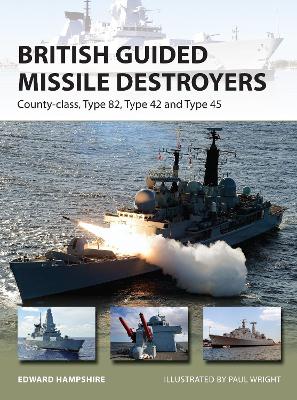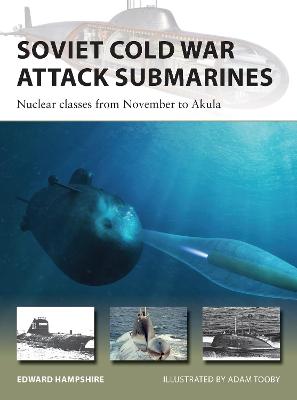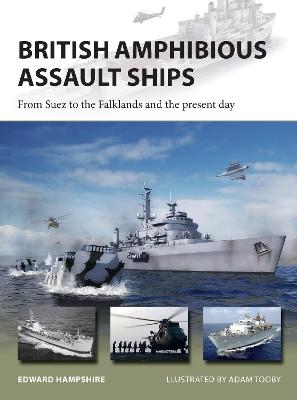New Vanguard
2 primary works • 4 total works
Book 234
In the years after World War II, new guided missile technology offered surface ships the chance to destroy airborne threats from afar, thereby preserving their role in naval warfare. This book examines the technology and combat performance of Britain's guided missile destroyers over half a century.
Uniquely among modern destroyers, three of these classes have been tested in battle against the aircraft and missiles of another modern navy - in the Falklands War - as well as being deployed during the Gulf War. Written by an expert on British naval technology, this book assess the changing technology of the Royal Navy's destroyers over half a century, including an examination of the Royal Navy's newest and most capable warship, the Type 45.
Uniquely among modern destroyers, three of these classes have been tested in battle against the aircraft and missiles of another modern navy - in the Falklands War - as well as being deployed during the Gulf War. Written by an expert on British naval technology, this book assess the changing technology of the Royal Navy's destroyers over half a century, including an examination of the Royal Navy's newest and most capable warship, the Type 45.
Book 242
Heavily armed and formidable, guided missile cruisers formed the core of the Soviet Navy during the Cold War. From the last class of conventional Sverdlov-class cruisers through to increasingly complex and formidable missile cruisers, these ships ensured that NATO took the Soviet naval threat seriously. Soviet Cold War Guided Missile Cruisers covers all classes of these impressive warships, from the early Sverdlov through the Kynda, Kresta, Kara and Slava to the enormous Kirov classes. Together, these vessels marked the apogee of Soviet naval technology and capability and they remain today the largest non-aircraft carrier warships built since 1945. Containing material previously only available in Russian and fully researched from specialist defence journals, this comprehensive volume examines the design, development, and intended role of these impressive, hi-tech warships, and recounts their dramatic operational history as NATO and Soviet warships faced off against each other during the long Cold War at sea.
In this highly detailed book, naval historian Edward Hampshire reveals the fascinating history of the nuclear-powered attack submarines built and operated by the Soviet Union in the Cold War, including each class of these formidable craft as they developed throughout the Cold War period.
The November class, which were the Soviet Union’s first nuclear submarines, had originally been designed to fire a single enormous nuclear-tipped torpedo but were eventually completed as boats firing standard torpedoes. The Alfa class were perhaps the most remarkable submarines of the Cold War: titanium-hulled (which was light and strong but extremely expensive and difficult to weld successfully), crewed with only thirty men due to considerable automation and 30% faster than any US submarines, they used a radical liquid lead-bismuth alloy in the reactor plant. The Victor class formed the backbone of the Soviet nuclear submarine fleet in the 1970s and 1980s, as hunter-killer submarines began to focus on tracking and potentially destroying NATO ballistic missile submarines. The Sierra classes were further titanium-hulled submarines and the single Mike-class submarine was an experimental type containing a number of innovations. Finally, the Akula class were being constructed as the Cold War ended, and these boats form the mainstay of the Russian nuclear attack submarine fleet today.
This book explores the design, development, and deployment of each of these classes in detail, offering an unparalleled insight into the submarines which served the Soviet Union throughout the Cold War period. The text is supported by stunning illustrations, photographs and diagrams of the submarines.
The November class, which were the Soviet Union’s first nuclear submarines, had originally been designed to fire a single enormous nuclear-tipped torpedo but were eventually completed as boats firing standard torpedoes. The Alfa class were perhaps the most remarkable submarines of the Cold War: titanium-hulled (which was light and strong but extremely expensive and difficult to weld successfully), crewed with only thirty men due to considerable automation and 30% faster than any US submarines, they used a radical liquid lead-bismuth alloy in the reactor plant. The Victor class formed the backbone of the Soviet nuclear submarine fleet in the 1970s and 1980s, as hunter-killer submarines began to focus on tracking and potentially destroying NATO ballistic missile submarines. The Sierra classes were further titanium-hulled submarines and the single Mike-class submarine was an experimental type containing a number of innovations. Finally, the Akula class were being constructed as the Cold War ended, and these boats form the mainstay of the Russian nuclear attack submarine fleet today.
This book explores the design, development, and deployment of each of these classes in detail, offering an unparalleled insight into the submarines which served the Soviet Union throughout the Cold War period. The text is supported by stunning illustrations, photographs and diagrams of the submarines.
Amphibious assault ships have been at the centre of nearly all of Britain's expeditionary campaigns since World War II, from the Suez crisis of 1956 to operations as far afield as Borneo (1963-66), the Falklands (1982), Sierra Leone (2000) and Iraq (2003).
In major operations such as Suez and the Falklands, the use of amphibious assault ships was essential to the military success of the campaigns. The Suez Crisis saw two of the Royal Navy's former light fleet carriers converted into 'commando carriers' to specialise in amphibious warfare. In the 1960s these were followed by the famous Fearless class ships - the first purpose-built amphibious assault ships in the Royal Navy. With an internal dock, headquarters capability, and multiple landing craft, these 'Landing Platform Docks' were built to project power around the world. When the Falklands were invaded, HMS Fearless was the key to the successful landing in San Carlos.
In the 1990s, a new generation was ordered: the helicopter carrier HMS Ocean and the Albion class LPDs. In recent years Ocean, Albion and Bulwark have been the largest fighting ships of the Royal Navy and have acted as the navy's flagships, as well as being perhaps the most versatile ships in the navy.
This title is an essential guide to British Amphibious Assault Ships across the decades, from the mighty Fearless to the modern Albion. Packed with full-colour illustrations, contemporary photography, and detailed analysis, this definitive work explores the history, development, and deployment of the Royal Navy's front line.
In major operations such as Suez and the Falklands, the use of amphibious assault ships was essential to the military success of the campaigns. The Suez Crisis saw two of the Royal Navy's former light fleet carriers converted into 'commando carriers' to specialise in amphibious warfare. In the 1960s these were followed by the famous Fearless class ships - the first purpose-built amphibious assault ships in the Royal Navy. With an internal dock, headquarters capability, and multiple landing craft, these 'Landing Platform Docks' were built to project power around the world. When the Falklands were invaded, HMS Fearless was the key to the successful landing in San Carlos.
In the 1990s, a new generation was ordered: the helicopter carrier HMS Ocean and the Albion class LPDs. In recent years Ocean, Albion and Bulwark have been the largest fighting ships of the Royal Navy and have acted as the navy's flagships, as well as being perhaps the most versatile ships in the navy.
This title is an essential guide to British Amphibious Assault Ships across the decades, from the mighty Fearless to the modern Albion. Packed with full-colour illustrations, contemporary photography, and detailed analysis, this definitive work explores the history, development, and deployment of the Royal Navy's front line.



